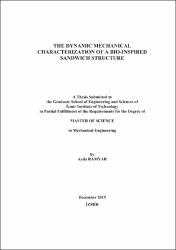Please use this identifier to cite or link to this item:
https://hdl.handle.net/11147/9661Full metadata record
| DC Field | Value | Language |
|---|---|---|
| dc.contributor.advisor | Taşdemirci, Alper | - |
| dc.contributor.advisor | Güden, Mustafa | - |
| dc.contributor.author | Ramyar, Ayda | - |
| dc.date.accessioned | 2020-10-06T08:27:58Z | |
| dc.date.available | 2020-10-06T08:27:58Z | |
| dc.date.issued | 2019-12 | - |
| dc.identifier.citation | Ramyar, A. (2019). The dynamic mechanical characterization of a bio-inspired sandwich structure. Unpublished master's thesis, İzmir Institute of Technology, İzmir, Turkey | en_US |
| dc.identifier.uri | https://hdl.handle.net/11147/9661 | - |
| dc.description | Thesis (Master)--Izmir Institute of Technology, Mechanical Engineering, Izmir, 2019 | en_US |
| dc.description | Includes bibliographical references (leaves: 99-106) | en_US |
| dc.description | Text in English; Abstract: Turkish and English | en_US |
| dc.description.abstract | In this study, the sandwich structure consisting of novel-3D-printed-polymeric base core was examined in terms of crashworthiness. The designed core structure for energy absorption purpose is inspired by the geometry of the human fingerprint. The fingerprint geometry is a spiral-shaped, asymmetrical and complex structure; therefore, the manufacturing of the geometry is difficult by conventional manufacturing methods. Fused Deposition Modeling (FDM) which is one of the additive manufacturing (AM) methods was used for fingerprint core preparation by layer by layer production technique with low-density material. After the material characterization of 3D printed thermoplastic specimens, optimum geometric parameters of fingerprint were determined via experimental and numerical studies by changing the height and thickness. The fingerprint performed better crushing performance compared to other conventional geometries. Quasi-static and dynamic crushing experiments were conducted, and the results were verified with models by non-linear finite element code LS-DYNA. The results showed that the energy absorption capacity and peak crushing force of fingerprint geometry increases with strain rate increment. However, the deformation behavior of the structure under dynamic loads changes and the material becomes more brittle. This is caused by the change in deformation mechanism due to AM and material itself. It was found that the 3-D printed core structure is suitable to be employed at low-to-medium strain rates due to its multi-stage deformation behavior. It was observed that the bio-inspired sandwich structure consisting of 4 fingerprint-core can absorb 10% more impact energy than fourfold individual 3-D printed core geometry, which indicates the promising potential of the novel sandwich structure for crashworthiness applications. | en_US |
| dc.description.abstract | Bu çalışmada, 3 boyutlu (3D) yazıcıda üretilmiş özgün çekirdek yapısı içeren sandviç yapının enerji emme niteliği incelenmiştir. Sandviç yapılarda çekirdek, enerji emilimini üstlendiği için yenilikçi çekirdek tasarımı oldukça önem taşımaktadır. Çalışmada enerji emme performansını iyileştirme amacıyla kullanılan çekirdek yapısı insan parmak izinden esinlenerek tasarlanmıştır. İnsan parmak izi geometrik olarak spiral, asimetrik ve kompleks bir yapıya sahip olduğu için bu geometrinin üretimi geleneksel üretim metotları ile zor ve zaman alıcıdır. Eklemeli üretim metotları geniş üretim olanakları sunmaktadır. Bu çalışmada eklemeli üretim metotlarından biri olan FDM, parmak izi çekirdek yapısının katmanlı üretim tekniği ile üretilmesinde kullanılmıştır. 3D ile üretilmiş termoplastik numunelerinin malzeme karakterizasyonu yapıldıktan sonra parmak izinin optimum geometrik parametreleri, yükseklik ve kalınlık değerleri değiştirilerek deneysel ve nümerik çalışmalarla belirlenmiştir. Ayrıca parmak izi geometrisinin, geleneksel yapılara göre daha iyi enerji emme performansı gösterdiği saptanmıştır. Statik ve dinamik ezilme deneylerinden elde edilen sonuçlar, LS-DYNA sonlu elemanlar analiz programında modellenerek sonuçlar doğrulanmıştır. Bu sonuçlar, parmak izi geometrisinin enerji emme kapasitesinin ve ilk pik kuvvet değerinin deformasyon hızının artmasıyla birlikte arttığını göstermiştir. Buna karşılık, yapının dinamik yükler altındaki deformasyon davranışının değiştiği ve daha kırılgan hale geldiği gözlemlenmiştir. Bunun nedeninin seçilen üretim yöntemi ve bu yöntemde kullanılan malzeme olduğu gözlemlenmiştir. Deformasyon hızına bağlı değişen deformasyon karakteristiği incelendiğinde yapının düşük-orta deformasyon hızlarında daha iyi çalışabileceği saptanmıştır. Dörtlü parmak izi geometrisinden oluşan çekirdek yapı ihtiva eden sandviç yapının, parmak izinin tekli ezilme davranışının 4 katından %10 daha fazla enerji emme özelliğine sahip olduğu gözlemlenmiştir. | en_US |
| dc.format.extent | xiv, 106 leaves | - |
| dc.language.iso | en | en_US |
| dc.publisher | Izmir Institute of Technology | en_US |
| dc.rights | info:eu-repo/semantics/openAccess | en_US |
| dc.subject | Bio-inspired structures | en_US |
| dc.subject | Sandwich structure | en_US |
| dc.subject | Fused deposition modeling | en_US |
| dc.subject | Dynamic characterization | en_US |
| dc.title | The Dynamic Mechanical Characterization of a Bio-Inspired Sandwich Structure | en_US |
| dc.title.alternative | Biyobenzetim Tabanlı Sandviç Yapının Dinamik Mekanik Karakterizasyonu | en_US |
| dc.type | Master Thesis | en_US |
| dc.institutionauthor | Ramyar, Ayda | - |
| dc.department | Thesis (Master)--İzmir Institute of Technology, Mechanical Engineering | en_US |
| dc.relation.publicationcategory | Tez | en_US |
| dc.identifier.wosquality | N/A | - |
| dc.identifier.scopusquality | N/A | - |
| item.cerifentitytype | Publications | - |
| item.openairetype | Master Thesis | - |
| item.openairecristype | http://purl.org/coar/resource_type/c_18cf | - |
| item.grantfulltext | open | - |
| item.languageiso639-1 | en | - |
| item.fulltext | With Fulltext | - |
| Appears in Collections: | Master Degree / Yüksek Lisans Tezleri | |
Files in This Item:
| File | Description | Size | Format | |
|---|---|---|---|---|
| 10173212.pdf | MasterThesis | 24.2 MB | Adobe PDF |  View/Open |
CORE Recommender
Page view(s)
476
checked on May 12, 2025
Download(s)
534
checked on May 12, 2025
Google ScholarTM
Check
Items in GCRIS Repository are protected by copyright, with all rights reserved, unless otherwise indicated.